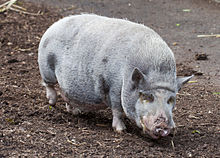

The Turopolje pig (Croatian: Turopoljska svinja) is a breed of pig named for Turopolje, Croatia, where it originates. This distinctive-looking swine, which has black spots on a white or grey skin with drooping ears,[1] is very rare, and is likely nearing extinction.[2] It is one of the older breeds of European pigs, though it may have had infusions of Berkshire or other bloodlines in the 19th century.[3]
Though it is relatively small and not fast growing,[4] the breed is known for its hardiness under free range conditions.[5] Once one of the most widespread swine in its native country, the change from extensive to intensive pig farming in the mid-20th century discouraged its use.[2]
References[edit]
- ^ "Turopolje", ansi.okstate.edu, Oklahoma State University, archived from the original on 2013-03-30
- ^ a b Matija Harcet; Marija Đikić; Vera Gamulin (2006), "Low Genetic Diversity of the Turopolje Pig Breed" (PDF), Food Technology and Biotechnology, ISSN 1330-9862
- ^ Valerie Porter (2002), Mason's World Dictionary of Livestock Breeds, Types, and Varieties, CABI, p. 253, ISBN 9780851994307
- ^ Max Frederick Rothschild; Anatoly Ruvinsky (31 March 2011), The Genetics of the Pig, CABI, ISBN 9781845937560
- ^ Sepp Holzer (11 April 2011), Sepp Holzer's Permaculture: A Practical Guide to Small-Scale, Integrative Farming and Gardening, Chelsea Green Publishing, ISBN 9781603583701
External links[edit]
Picture of sleeping (and video of snoring) Turopolje pigs in South Tyrol: https://picasaweb.google.com/Fritz.Joern/HofSommer13#5912816864147895490
Well, that’s interesting to know that Psilotum nudum are known as whisk ferns. Psilotum nudum is the commoner species of the two. While the P. flaccidum is a rare species and is found in the tropical islands. Both the species are usually epiphytic in habit and grow upon tree ferns. These species may also be terrestrial and grow in humus or in the crevices of the rocks.
View the detailed Guide of Psilotum nudum: Detailed Study Of Psilotum Nudum (Whisk Fern), Classification, Anatomy, Reproduction